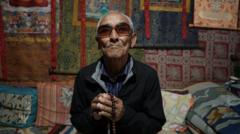Eighty-five-year-old Dawa Sangbo arrived in India from Tibet in 1970, embodying a story shared by many Tibetan refugees who's fled their homeland following a failed uprising against Chinese rule in 1959. Tenzin Tsundue, a Tibetan writer and activist, reflects on this collective trauma faced by around 70,000 Tibetans currently living across India, who are often recognized in their host country as refugees rather than citizens.
Living under conditions of uncertainty, many Tibetans hold renewable registration certificates that tie them to their identity as exiles. Born in India, they face additional layers of bureaucracy if they wish to pursue any form of Indian citizenship—a choice many hesitate to make, fearing the loss of their Tibetan identity.
During a recent gathering in Dharamshala to celebrate the 90th birthday of the Dalai Lama, Tibetans expressed a mix of gratitude for their refuge in India and profound sadness over their stateless existence. Events like this are bittersweet, as attendees recognize the cultural distance from their homeland while also acknowledging the risks of returning to Tibet due to heightened restrictions.
Dawa Sangbo recalls his dangerous journey through Nepal to reach India, a journey marked by fear and desperation. His story, much like that of many fellow exiles, accentuates the indelible bond they maintain with their homeland, despite having built lives in a foreign land.
Younger Tibetans living in India face a unique challenge, born into the reality of displacement. Many express a deep sense of loss, questioning their belonging and the cultural heritage that has been systematically stripped away. Lobsang Yangtso, a researcher, articulates this pain of being stateless as an experience of living without a sense of home.
Despite their gratitude towards India for the refuge, Tibetans cannot fully embrace their existence here. They are often excluded from basic rights such as voting, ownership of property, and even employment opportunities due to their refugee status, which complicates their economic stability.
In recent years, a significant number of Tibetans have sought new lives in Western nations, often driven by both economic prospects and personal needs—many have not seen family members in decades, adding emotional weight to their aspirations for citizenship in countries like the U.S. and Canada.
As the Dalai Lama mentors future leaders and discusses his succession plan, there is a sense of tension around the future of the Tibetan movement. Penpa Tsering, president of the Central Tibetan Administration, remains cautiously optimistic, urging for preparation to ensure the continuity of their struggle. However, there is a palpable anxiety regarding the community's fate post-Dalai Lama, as many fear the potential loss of support that has been pivotal for their identity and activism.
Amidst the ongoing struggle, Tibetans continue to dream of returning home. But for now, their reality in India is marked by a persistent quest for identity, rights, and a hope that one day, they might return to their homeland.






















